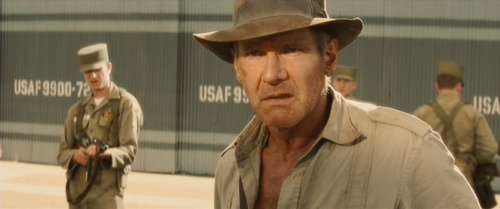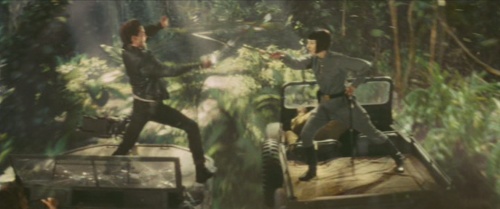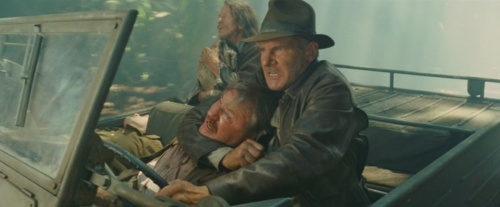Indiana Jones and the Kingdom of the Crystal Skull (Steven Spielberg, 2008)
Man, this is some bad movie.
And keep in mind; this is from someone who managed to enjoy some of the Star Wars prequels.
I didn’t expect Indiana Jones and the Kingdom of the Crystal Skull to be at the level of its predecessors, but I did expect that Spielberg would at least deliver an enjoyable or halfway competent movie. I thought I would probably get a whole lot of stuff that didn’t really feel like classic Indiana Jones, but which had, say, a few really good action sequences in it, much as Indiana Jones and the Last Crusade feels half-baked for much of its length but then has that awesome tank chase. We don’t get to see Spielberg do full-on action very often any more, so I would have been happy with that. But Crystal Skull just sort of sits there; it never comes alive.
The flame flickers for a while: Spielberg, along with cinematographer Janusz Kaminski, does a decent job of reproducing the look and shooting style of the original films. Harrison Ford is okay without being great; he isn’t helped by a lot of lazy, pre-fabricated joke lines (“That can’t be good…” and the like). But when we get into the first of the film’s action scenes, the editing isn’t very crisp, and the pulse never gets going. Spielberg has made much of his attempt to return to the style of editing he used on the originals; and as I have said several times elsewhere (most notably here) the Indiana Jones films were notable for a more measured construction than most other action films. Yet here that just becomes a kind of slack flabbiness to the editing. You can certainly read the action clearly – always the strength of the way Spielberg shoots and cuts – but we seem to be getting into shots too early and out of them too late. (This is really mystifying, since Spielberg’s veteran editor, Michael Kahn, is one of the few key crewmembers he has retained since Raiders of the Lost Ark). The gears never click, and you start to become conscious of how badly Harrison Ford moves.
For the first hour and a half, the film actually reversed my expectations: I had expected good action, but that the film wouldn’t feel like it was in quite the same Indiana Jones universe as the originals. Instead, the expository scenes actually did a pretty good job of placing us back in the series’ milieu, but Spielberg just hasn’t brought his A-game to the action. Neither the early chase in the warehouse, nor the motorcycle chase around campus, ever hit high gear: they reminded me of the little throwaway second-order action scenes Spielberg would toss into the earlier films almost as a bonus, like the sidecar chase in Last Crusade. Other sequences, like a fight in a graveyard, seem to be over before they really start. By the time Crystal Skull got to its centrepiece jungle chase, I was growing impatient, but was still eager for my big pay-off: but that sequence doesn’t deliver either. People leap from car to car and punch each other, but Spielberg never finds anything more interesting to do, and squanders obvious opportunities. Why, for example, having established that the villains have a giant tree-cutting machine covered in whirling blades, does he have Indiana Jones almost immediately blow it up? In the original films, characters would have been jumping on and off it; having to race against time to get out of the way of the blades; using it to dispatch villains in gruesome style; and so on. Instead, we get some very unconvincing staging: most notably when Indiana’s sidekick Mutt Williams (Shia Le Bouf, who is fine, incidentally) ends up doing the splits between two cars while being whacked in the groin by passing trees.
It isn’t that this is fundamentally more implausible than anything in the original films; but it’s all about how the filmmakers sell the gag. It has to be either made plausible through careful staging (think of the way in Raiders it is somehow convincing that Indiana Jones can throw a fully grown man through the windscreen of a truck), or at least pulled off with a showman’s flourish (like that over-the-top moment in Temple of Doom when the minecar flies across a chasm and lands perfectly on the rails on the other side). Here, Spielberg holds moments like these too long, plays them too broadly, and shows no instinct for which jokes are funny enough that the audience will grant him some licence. It also doesn’t help that the whole setting for the jungle chase looks so phoney, obviously done largely in front of green-screens in computer-generated surroundings. It’s bewildering that Spielberg has talked in interviews about keeping the effects largely practical: the film is chock full of CGI, much of it terrible. There is a scene where Mutt comes to the rescue swinging on vines Tarzan style, accompanied by an army of CGI monkeys. It is a bad idea badly realised, with awful effects and not even any zip in the execution (ditto regarding another moment involving a car, a river and a tree). The use of computerised effects also robs the signature Indiana Jones creepy-crawly sequence of any menace: a sequence involving a colony of giant ants should have sent a shiver up the spine, but instead comes across as a pale imitation of the much better use of a similar idea in Peter Jackson’s King Kong.
What about the stuff around the action? (Spoilers start here, for what it’s worth; this is a film that spoils itself). Well, people are going to walk out complaining about the use of a science fiction conceit, which doesn’t really fit into the rules of the series thus far. I didn’t mind that so much, in principle. George Lucas – and it was his idea, one with which Spielberg and Harrison Ford were apprently never terribly comfortable – has justified it on the grounds that the setting has shifted to the fifties, so he thought it appropriate to use a conceit from a 1950s B-science fiction movie. As an intellectual rationalisation, this is fine, but it doesn’t actually work that way, because nothing in the film ever actually evokes the iconography of those movies: it’s just regular Indiana Jones, but with aliens. Again, though, that wasn’t my problem per se. I was more bothered by the tediousness of the set-up. There’s always a back story to the mythology in these films, and a process of following clues, but all that stuff is particularly long-winded and clunky here. What’s more, there are elements to the plot and dialogue that suggest nobody even tried to make it hang together properly. For example, the treacherous character of Mac at first appears to be purely out for profit; he then convinces everyone he’s a good guy working for the Central Intelligence Agency. Yet when they walk into mythical lost city at the end, he complains loudly about the lack of treasure. Why does nobody ask him what happened to the CIA?
The whole thing is mystifying. Not just because Spielberg’s work here is so anonymous (this doesn’t even feel like bad Spielberg; the action scenes, in particular, feel like they could have been shot by anyone). No, the real mystery is that this has gotten decent and even enthusiastic reviews. I’m a big fan of the series, a registered Spielberg apologist, and have even been known to enjoy and make excuses for George Lucas’ lesser films. And I just cannot see what others found to like here. Could it be that there are two versions of the film out there? My sense of disconnect from those who have given the film good reviews is that profound. I walked out shaking my head, wondering if Spielberg’s only agenda was to ensure that nobody ever pestered him for another Indiana Jones film ever again.
Related Items
For a much happier Indiana Jones experience, see my tribute to Temple of Doom here.


